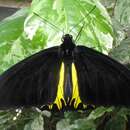Biology
provided by Arkive
The female common birdwing lays single eggs, which she attaches to the surface of the Indian birthwort leaves. After hatching about four to five days later, the emerging caterpillar consumes the eggshell and then begins to eat the surrounding leaves, feeding both day and night (2).
After around three to four weeks the caterpillar begins its transformation into a pupa, which takes two days. The pupa remains in this state for the next two weeks as the metamorphosis into a butterfly progresses. After a total of 40 or more days from the moment the egg is laid, the adult common birdwing emerges from the pupa, allowing its wings to dry before attempting its first flight. The adult lives for around four to six weeks, feeding and mating before it dies (2).
Conservation
provided by Arkive
The common birdwing is protected from collection from the wild in Malaysia and Singapore, and the Papua New Guinea government require collectors to only acquire specimens from captive-bred populations (2) (7). This species is also protected in Hong Kong under the Wild Animals Protection Ordinance, where all birdwings are additionally listed under Schedule 1 of the Animals and Plants (Protection of Endangered Species) Ordinance, which regulates the trading and possession of these butterflies (8). In addition, Indian birthwort is protected in Hong Kong under the Forestry Regulations of the Forests and Countryside Ordinance (8). In Singapore the common birdwing is found at the Botanical Gardens and at Singapore Zoo, where its food and breeding plant can still be found (2). Since this beautiful butterfly's success in the wild is inextricably linked to the diversity of Indian birthwort, the continued conservation of this plant is fundamental to maintaining the wide distribution the common birdwing currently enjoys (5).
Description
provided by Arkive
The common birdwing is amongst the largest and most beautiful butterflies in Asia (3) (4). The dramatic contrast of golden yellow hind-wings and glossy black forewings gives this species a striking appearance (3), and serves as a protection mechanism by warning potential predators that it is distasteful (2). The upper surface of the golden hind-wings features black boarders and veins, with females additionally possessing a row of large, triangular black spots (4). A prominent pink saddle distinguishes the caterpillar of this species, and the pupa has a leafy appearance that helps to camouflage it from predators (2).
Habitat
provided by Arkive
Found in primary and secondary forest and scrub from sea-level to 1000 metres elevation (3) (5). This butterfly is also often drawn to cultivated areas where its food plant, Indian birthwort (Aristolochia tagala), can be found (2). Breeding only occurs on the Indian birthwort vine (6).
Range
provided by Arkive
The common birdwing enjoys the widest distribution of all birdwings, stretching from India and Nepal in the west, to China in the north, and down through Southeast Asia to Indonesia in the south and east (5).
Status
provided by Arkive
Listed on Appendix II of CITES (1).
Threats
provided by Arkive
The common birdwing is threatened mainly by habitat loss as forests are removed for urbanisation and conversion to agricultural land. (6) (2). This butterfly is particularly sensitive to habitat loss because of its total reliance on one plant species, the Indian birthwort, for its food and breeding site (6). Thus, the scarcity of this plant has made the common birdwing extremely vulnerable (2). This beautiful butterfly is also highly sought after by collectors, and may be captured from the wild in some parts of its range (2).

